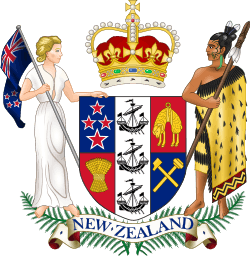Government of New Zealand
 |
| This article is part of a series on the politics and government of New Zealand |
| Constitution |
|
|
|
Judiciary
|
|
Related topics |
The Government of New Zealand (Māori: Te Kāwanatanga o Aotearoa), formally Her Majesty's Government in New Zealand,[1] is the administrative complex through which authority is exercised in New Zealand. Based on the Westminster system of responsible government, executive power in New Zealand is based on the principle that "The Queen reigns, but the government rules, so long as it has the support of the House of Representatives".[2]
The head of state of New Zealand is the Queen, Elizabeth II, who is represented in New Zealand by the Governor-General. The Queen and the Governor-General follow the advice of the government and play only a formal role in the executive, except with respect to the formation of governments and the use of reserve powers.
The head of government is the Prime Minister. Prime ministers are not directly elected; by convention the office is held by the party leader who commands a majority in the House. Prime ministers will typically resign if they lose a leadership challenge or lose their majority—usually at an election (held every 3 years). The Prime Minister is formally appointed by the Governor-General who also has the reserve power to dismiss a Prime Minister. In practice the Prime Minister is determined by size of each political party, support agreements between parties and leadership votes in the party that leads the government.
As of October 2014 the Prime Minister of New Zealand is the leader of the National Party, John Key—who has negotiated formal support agreements for the incoming Parliament with the Māori Party, United Future and Act.
The Executive Council is the formal body that exercises government's regulatory power. It contains all government ministers and the Governor-General. Ministers must be members of Parliament and appointments are made by the Governor-General on the advice of the Prime Minister. The majority of ministers are also members of Cabinet, the government's political decision-making committee. A few more junior ministers are part of the executive council but are outside cabinet. Most ministers have a portfolio of specific responsibilities such as departments or policy areas, although ministers without portfolio are sometimes appointed.
History
New Zealand had been granted self-government in 1853 following the New Zealand Constitution Act 1852, which was an Act of the Parliament of the United Kingdom. Governments were set up at state and at provincial level, with initially six provinces. The provinces were abolished by the Abolition of Provinces Act 1876, during the Premiership of Harry Atkinson. For the purposes of the Act, the provinces formally ceased to exist on 1 January 1877.[3]
The first government that formed along political lines did not appear until 1891, when John Ballance formed the Liberal Party and the Liberal Government.
List of governments
See also
- Politics of New Zealand
- High Court of New Zealand - Judiciary
References
- ↑ "Seal of New Zealand Act 1977".
- ↑ Sir Kenneth Keith, quoted in the Cabinet Manual
- ↑ "Provinces 1848–77". http://rulers.org. Retrieved 26 April 2013. External link in
|publisher=(help)